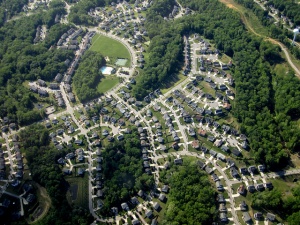Difference between revisions of "Better site design"
| (3 intermediate revisions by 2 users not shown) | |||
| Line 17: | Line 17: | ||
The strategies need to be considered together as they all overlap and relate to each other. For example, preserving a natural channel will impact the layout of the site, and the layout of the site determines the extent of impervious area and optimal locations of structural BMPs. | The strategies need to be considered together as they all overlap and relate to each other. For example, preserving a natural channel will impact the layout of the site, and the layout of the site determines the extent of impervious area and optimal locations of structural BMPs. | ||
Take a look at the downloadable | Take a look at the downloadable Site Design Strategies Factsheet below for a .pdf overview of LID Best Management Practices: | ||
{{Clickable button|[[File:Site design.png|150 px|link=https://wiki.sustainabletechnologies.ca/images/a/a8/Design_strategies_final.pdf]]}} | {{Clickable button|[[File:Site design.png|150 px|link=https://wiki.sustainabletechnologies.ca/images/a/a8/Design_strategies_final.pdf]]}} | ||
| Line 27: | Line 27: | ||
<pdf width="500" height="700">File:Better-Site-Design-Handbook.pdf</pdf> <pdf width="500" height="700">File:2 UrbanDesignCompendium.pdf</pdf> | |||
---- | ---- | ||
[[category:planning]] | [[category:planning]] | ||
Latest revision as of 19:46, 3 November 2021
Increases in the quantity, rate, and frequency of runoff can be linked to two root causes:
- the conversion of undeveloped or agricultural land cover to urban uses, and
- the application of storm sewer systems.
The goal of LID site design strategies is to minimize these two sources of hydrologic impacts. Avoiding downstream impacts through non-structural, innovative site design methods is more economical, operationally efficient, and aesthetically pleasing than concentrating all stormwater management efforts on treating and controlling runoff downstream.
Site designer should exhaust all opportunities for non-structural methods to prevent runoff from being generated before determining how to mitigate the land cover change and storm sewer impacts through structural LID practices and detention ponds.
LID site design strategies can be grouped into four themes:
- Preserving existing hydrologic features and functions;
- Siting and layout of development;
- Reducing impervious area; and
- Using natural drainage systems.
The strategies need to be considered together as they all overlap and relate to each other. For example, preserving a natural channel will impact the layout of the site, and the layout of the site determines the extent of impervious area and optimal locations of structural BMPs.
Take a look at the downloadable Site Design Strategies Factsheet below for a .pdf overview of LID Best Management Practices:
Additional resources[edit]
Better Site Design Handbook, Centre for Watershed Protection (1998) & Urban Design Compendium, English Partnerships (2007)[edit]
Click below to review the following Site Design resources:

